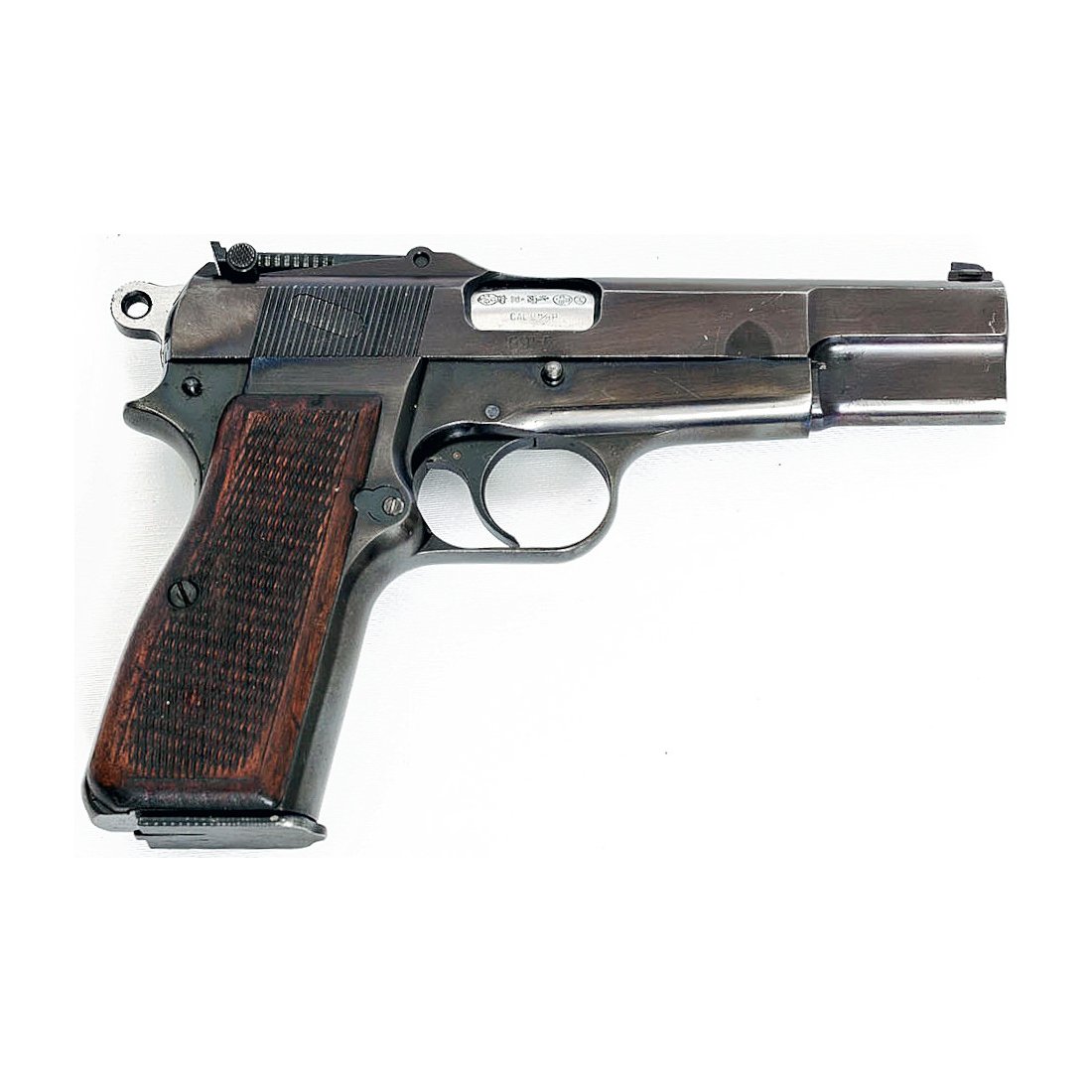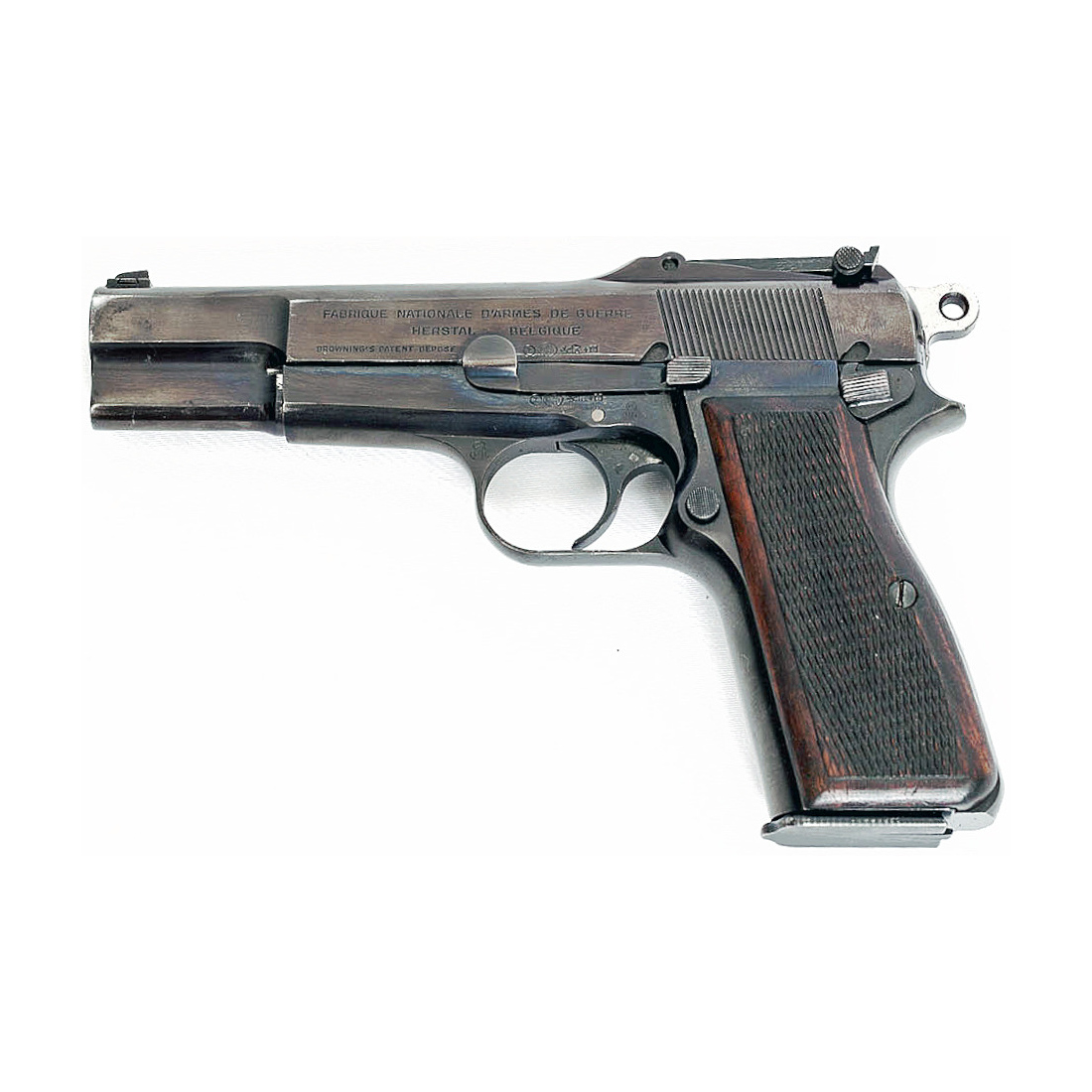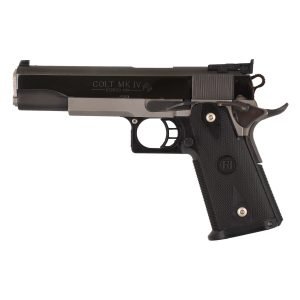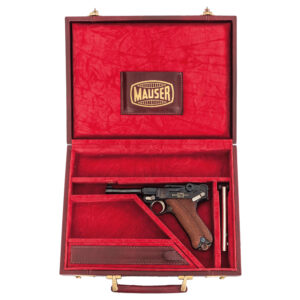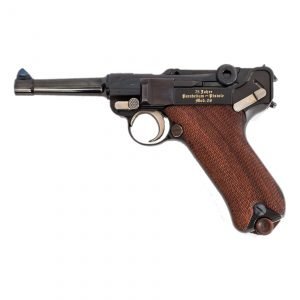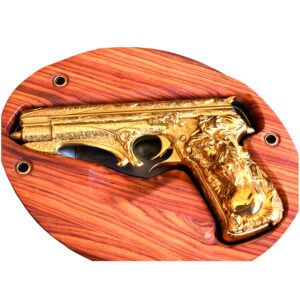FN Browning Hi-Power 35 Capitan 9x19mm
FN Browning Hi-Power 35 Askeri Tip 9mm 14’lü
Model: Hi Power HP-35 Capitan (askeri tip)
Çapı: 9×19 mm Parabellum (9 mm)
Namlu Boyu: 4.7″ (119 mm)
Kapasite: 13+1
Ağırlık: 35 oz | 1.000 gr (boş)
Uzunluk: 7.8″ | 197 mm
Sistem: Short Recoil – Single Action
Açıklama: Askeri tip, ayarlı ve nişangahlı geze sahip çok özel bir 14’lü Browning
Açıklama
Fabrique Nationale (FN) Browning Hi-Power 35 Capitan
The Browning Hi Power is a single-action, semi-automatic handgun available in the 9mm and .40 S&W calibers. It is based on a design by American firearms inventor John Browning, and completed by Dieudonné Saive at Fabrique Nationale (FN) of Herstal, Belgium. Browning died in 1926, several years before the design was finalized. The Hi-Power is one of the most widely used military pistols in history, having been used by the armed forces of over 50 countries. After 82 years of continuous production, the Hi-Power was discontinued in 2017 by Browning Arms, but it remains in production under license.
The Hi Power name alludes to the 13-round magazine capacity, almost twice that of contemporary designs such as the Luger or Colt M1911. The pistol is often referred to as an HP (for “Hi-Power” or “High-Power”), GP (for the French term, “Grande Puissance”), BAP (Browning Automatic Pistol), or BHP (Browning High-Power). The terms P-35 and HP-35 are also used, based on the introduction of the pistol in 1935. It is most often called the “Hi Power”, even in Belgium.
Development
The Browning Hi-Power was designed in response to a French military requirement for a new service pistol, the Grand Rendement (French for “high yield”), or alternatively Grande Puissance (literally “high power”). The French military required that:
the arm must be compact
the magazine have a capacity of at least 10 rounds
the gun have a magazine disconnect device, an external hammer, and a positive[clarification needed] safety
the gun be robust and simple to disassemble and reassemble
the gun be capable of killing a man at 50 metres
This last criterion was seen to demand a caliber of 9 mm or larger, a bullet mass of around 8 grams (123.5 grains), and a muzzle velocity of 350 m/s (1148 ft/s). It was to accomplish all of this at a weight not exceeding 1 kg (2.2 lb).
FN commissioned John Browning to design a new military sidearm conforming to this specification. Browning had previously sold the rights to his successful M1911 U.S. Army automatic pistol to Colt’s Patent Firearms, and was therefore forced to design an entirely new pistol while working around the M1911 patents. Browning built two different prototypes for the project in Utah and filed the patent for this pistol in the United States on 28 June 1923, granted on 22 February 1927. One was a simple blowback design, while the other was operated with a locked-breech recoil system. Both prototypes utilised the new staggered magazine design (by designer Dieudonné Saive) to increase capacity without unduly increasing the pistol’s grip size or magazine length.
The locked breech design was selected for further development and testing. This model was striker-fired, and featured a double-column magazine that held 16 rounds. The design was refined through several trials held by the Versailles Trial Commission.
In 1928, when the patents for the Colt Model 1911 had expired, Dieudonné Saive integrated many of the Colt’s previously patented features into the Grand Rendement design, in the Saive-Browning Model of 1928. This version featured the removable barrel bushing and take down sequence of the Colt 1911.
By 1931, the Browning Hi-Power design incorporated a shortened 13-round magazine, a curved rear grip strap, and a barrel bushing that was integral to the slide assembly. By 1934, the Hi-Power design was complete and ready to be produced. It was first adopted by Belgium for military service in 1935 as the Browning P-35. Ultimately, France decided not to adopt the pistol, instead selecting the conceptually similar but lower-capacity Modèle 1935 pistol.
Design
The Browning Hi-Power has undergone continuous refinement by FN since its introduction. The pistols were originally made in two models: an “Ordinary Model” with fixed sights and an “Adjustable Rear Sight Model” with a tangent-type rear sight and a slotted grip for attaching a wooden shoulder stock. The adjustable sights are still available on commercial versions of the Hi-Power, although the shoulder stock mounts were discontinued during World War II. In 1962, the design was modified to replace the internal extractor with an external extractor, improving reliability.
Standard Hi-Powers are based on a single-action design. Unlike modern double-action semi-automatic pistols, the Hi-Power’s trigger is not connected to the hammer. If a double-action pistol is carried with the hammer down with a round in the chamber and a loaded magazine installed, the shooter may fire the pistol either by simply squeezing the trigger or by pulling the hammer back to the cocked position and then squeezing the trigger. In contrast, a single-action pistol can only be fired with the hammer in the cocked position; this is generally done when a loaded magazine is inserted and the slide cycled by hand. In common with the M1911, the Hi-Power is therefore typically carried with the hammer cocked, a round in the chamber and the safety catch on (a carry mode often called cocked and locked in the United States or “made ready” in the UK, or sometimes called condition one).
The Hi-Power, like many other Browning designs, operates on the short-recoil principle, where the barrel and slide initially recoil together until the barrel is unlocked from the slide by a cam arrangement. Unlike Browning’s earlier Colt M1911 pistol, the barrel is not moved vertically by a toggling link, but instead by a hardened bar which crosses the frame under the barrel and contacts a slot under the chamber, at the rearmost part of the barrel. The barrel and slide recoil together for a short distance but, as the slot engages the bar, the chamber and the rear of the barrel are drawn downward and stopped. The downward movement of the barrel disengages it from the slide, which continues rearward, extracting the spent case from the chamber and ejecting it while also re-cocking the hammer. After the slide reaches the limit of its travel, the recoil spring brings it forward again, stripping a new round from the magazine and pushing it into the chamber. This also pushes the chamber and barrel forward. The cam slot and bar move the chamber upward and the locking lugs on the barrel re-engage those in the slide.
Design flaws
The pistol has a small number of design issues. The standard trigger pull is heavy, especially for a single-action pistol. This disadvantage is a consequence of the Hi-Power’s magazine disconnect safety, which was initially added to the model to meet the requirements of the French military in 1935. The standard Hi-Power magazine safety is connected to the trigger and is released by a plunger pressing on the surface of the magazine. This action of the plunger on the magazine adds tension to the trigger pull, and the required force to operate this feature adds resistance as well. This problem is often resolved by removing the magazine safety entirely, thus voiding the pistol’s warranty, or by polishing the interface surfaces between the safety plunger and the magazine. After-market trigger springs with reduced tension are also available to improve the trigger pull.
In addition, the pistol has a tendency to “bite” the web of the shooter’s hand, between the thumb and forefinger. This bite is caused by pressure from the hammer spur, or alternatively, by pinching between the hammer shank and grip tang.[citation needed] This problem can be fixed by altering or replacing the hammer, or by learning to hold the pistol to avoid injury. While a common complaint with the commercial models with spur hammers similar to that of the Colt “Government Model” automatic, it is seldom a problem with the military models, which have a smaller, rounded “burr” hammer, more like that of the Colt “Commander” compact version of the 1911.
Military service
Browning Hi-Power pistols were used during World War II by both Allied and Axis forces. After occupying Belgium in 1940, German forces took over the FN plant. German troops subsequently used the Hi-Power, having assigned it the designation Pistole 640(b) (“b” for belgisch, “Belgian”). Examples produced by FN in Belgium under German occupation bear German inspection and acceptance marks, or Waffenamts, such as WaA613. In German service, it was used mainly by Waffen-SS and Fallschirmjäger personnel.
High-Power pistols were also produced in Canada for Allied use, by John Inglis and Company in Toronto. The plans were sent from the FN factory to the UK when it became clear the Belgian plant would fall into German hands, enabling the Inglis factory to be tooled up for Hi-Power production for Allied use. Inglis produced two versions of the Hi-Power, one with an adjustable rear sight and detachable shoulder stock (primarily for a Nationalist Chinese contract) and one with a fixed rear sight. Production began in late 1944 and they were on issue by the March 1945 Operation Varsity airborne crossing of the Rhine into Germany. The pistol was popular with the British airborne forces as well as covert operations and commando groups such as the Special Operations Executive (SOE), the U.S. Office of Strategic Services (OSS) and the British Special Air Service (SAS) Regiment. Inglis High-Powers made for Commonwealth forces have the British designation ‘Mk 1’, or ‘Mk 1*’ and the manufacturer’s details on the left of the slide. They were known in British and Commonwealth service as the ‘Pistol No 2 Mk 1’, or ‘Pistol No 2 Mk 1*’ where applicable. Serial numbers were 6 characters, the second being the letter ‘T’, e.g. 1T2345. Serial numbers on pistols for the Chinese contract instead used the letters ‘CH’, but otherwise followed the same format. When the Chinese contract was cancelled, all undelivered Chinese-style pistols were accepted by the Canadian military with designations of ‘Pistol No 1 Mk 1’ and ‘Pistol No 1 Mk 1*’.
In the postwar period, Hi-Power production continued at the FN factory and, as part of FN’s product range which included the FN FAL rifle and FN MAG general-purpose machine gun. It has been adopted as the standard service pistol by over 50 armies in 93 countries. At one time most NATO nations used it, and it was standard issue to forces throughout the British Commonwealth. It was manufactured under licence, or in some cases cloned, on several continents. Former Iraqi ruler Saddam Hussein often carried a Browning Hi-Power. Former Libyan ruler Muammar Gaddafi carried a gold-plated Hi-Power with his own face on the design of the grips which was waved around in the air by Libyan rebels after his death. A Hi-Power was used by Mehmet Ali Agca during the assassination attempt of Pope John Paul II in 1981.
While the Hi-Power remains an excellent design, since the early 1990s it has been eclipsed somewhat by more modern designs which are often double-action and are manufactured using more modern methods. It remains in service throughout the world. As of 2017, the MK1 version remained the standard service pistol of the Canadian Armed Forces, with the SIG Sauer P226 being issued to specialised units along with the SIG Sauer P225. The weapon is the standard sidearm of the Belgian Army, Indian Army, Indonesian Armed Forces, Australian Defence Force, Argentine Army, Luxembourg Army, Israel Police, and Venezuelan Army, among others. The Irish Army replaced its Browning Pistols (known popularly as BAPs, or Browning Automatic Pistols) with the Heckler & Koch USP in 2007. From 2013 the British Army is replacing the Browning with the polymer-framed Glock 17 Gen 4 pistol, due to concerns about weight and the external safety of the pistol.
In 2017, FN ended production of the Hi-Power. The Hi-Power is still being produced under license by the Ishapore Rifle Factory in India.
Specifications of the Mk I
A locked-breech, semi-automatic, single-action, recoil-operated pistol. The Browning Hi-Power Mk I uses a 13-round staggered magazine.
Caliber: 9 mm
Length: 197 mm
Barrel length: 118 mm
length of rifled part: 100 mm
number of grooves: 6
direction of twist: right
Height (without sight, loaded): 127.5 mm
Width (with stocks): 36 mm
(without stocks): 25.5 mm
Weight (with empty magazine): 0.9 kg
(with loaded magazine): 1.060 kg
Capacity of magazine: 13 cartridges
Modes of fire: Single action
Muzzle velocity: 350 m/s
V12.50: 340 m/s
Muzzle energy: 500 J
Safeties: Half-cock notch, manual thumb safety, firing pin block, and magazine disconnect
Trigger pull: 7.5 lb
Effective Range: 50 m
Dispersion (firing 10 shots with rest)
at 15 metres: 95 mm (height 50 mm, width 45 mm)
at 30 metres: 200 mm (height 105 mm, width 95 mm)
at 50 metres: 320 mm (height 170 mm, width 150 mm)


